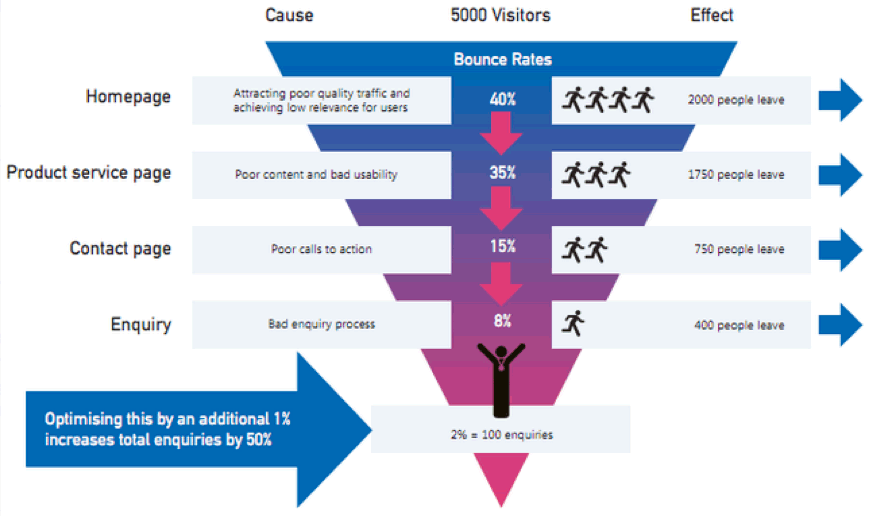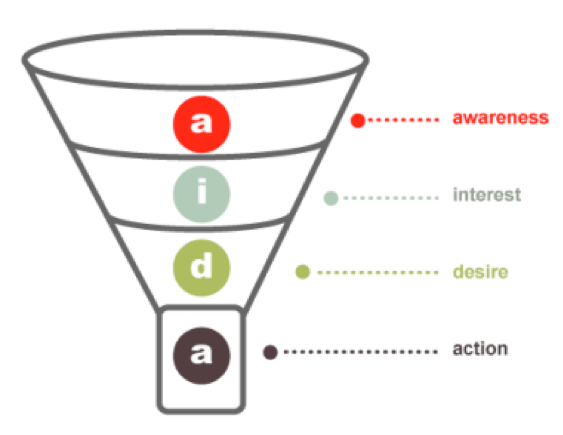Marketing your product online can be a complex and daunting process. With SEO becoming more and more complicated and social media eating up more of your time, spending a little time mapping out your sales funnel is becoming extremely important. So read on, I’ll guide you through setting up the essentials to help you convert your tire-kicking prospects into happy, loyal customers.
But What Is A Sales Funnel?
So, before we go about setting up an awesome sales funnel, let’s go over what a sales funnel actually is. A sales funnel is a marketing system. It’s the “ideal” process you intend your customers to experience as they go from prospect to lead to customer to repeat business. Let’s take a look at what this looks like.

This visualization is a bit complex, so let’s break it down a bit. The top, shows how your potential customers become aware of your products. Whether it’s through search results or paid ads. The next step is getting their interest. This is designated by the “click-through” and “landing page” portion of the funnel. This is where you get your 15 seconds to prove to your newly minted prospect that your product is exactly what they need and want. Why do I say 15 seconds? Because, studies have shown that the average time spent on a page is 15 seconds, if the user doesn’t see what they’re looking for in that time, they’re gone, most likely not to return. However, if you’ve piqued their interest and now their looking around, then congratulations you’ve reached them and now they’re going to see what you have to offer. This is where your awesome content leads them to the call to action, where they complete the action you want them to do, this could mean buying your product or it could just mean signing up to an email list.
It’s More Of A Guideline Really…
Now, your sales funnel isn’t actually a funnel strictly speaking. It’s more like a set of filters stacked on top of one another. Because, every person who visits your site, isn’t necessarily going to end up being a lead or a sale. The truth is, it’s probably only going to be around 1-5% of the customers who enter the funnel are going to come out at the end of the funnel. But, where did the other 95-99% go? Like I mentioned earlier, think of the funnel as a set of filters on top of one another. Each filter allows only the ones who qualify for the next step to go through, the rest leave through the sides. Here’s another image to show what I mean.

So, you probably could let all the ones who left go on to continue their internet journey, but you probably worked hard or paid for those leads, and by golly, you want recompense for your blood, sweat, tears, and money! Well, the most straightforward way to try and recapture that lost sale, is by getting those leads into a different funnel, maybe they weren’t actually interested in what they landed on, but, you have something else that they might be interested in.
Now that we’ve covered what a sales funnel is conceptually, let’s build a simple funnel that you can use for your website or store.
If You Build It, They Will Come
One little caveat before we get to it, to make an effective sales funnel takes time and experimentation, it doesn’t just happen overnight. It is also going to need a lot of TLC as best practices will always change and you’re going to need to understand how that affects your funnel, analyze what you can add to it, and how you can make it better. For our example funnel, we’re going to use a simple diagram, and you’re going to see a theme throughout the building process. This funnel is going to have four basic steps; Awareness, Interest, Desire, and Action as shown below.

Step 1 – Awareness
To have a sales funnel you need to pull prospects into your funnel. You do this by building awareness of you. To start, ask yourself, “How are my customers becoming aware of my product and where are they coming from?” From there, look at how people are coming to your site or to that particular product, and then consider the following:
- Are you using ads? If so, where? How much traffic is coming from there? Are they clicking it and going through to your site, or just moving on?
- What traffic are you getting from SERPS? Look at what pieces of content people are landing on, which ones are attracting more people?
- Are you on social media? If so, how many are coming from the big three (Facebook, Twitter, G+)? Are they just coming through and leaving? What’s attracting them?
Additionally, make sure that your content is attracting the right kind of people. All the clicks in the world, mean nothing if you’re not attracting the right kind of people onto your website and into your sales funnel. You’ll end up wasting time and money trying to convert them, and even if you do, they probably won’t be repeat business.
Step 2 – Interest
Alright, your prospects are aware of you and your product, and are starting their journey down the funnel, the next thing you need to do is build interest in what you’re selling. This is where your content and website come into play.
Good content will win the day with potential customers. Content and websites that keep visitors interested and engaged are paramount for helping the prospect get to know your company, and begin to build trust with you.
So…how do you know that your content is working and building the interest that you want? This can be done in numerous different ways that you can find on the internet, but one of the easiest is the bait piece call to action. What this is, is you write some content about a product or service that your company offers, and then wrap it up with a call to action for an email signup. Now this signup could be for a newsletter, offers, specials, bananas, doesn’t matter. The part that does matter to you is that you now have their information, and this is a great way to see who’s possibly interested in what you have to sell.
Step 3 – Desire
Now that you have that juicy lead information, it’s time to start making them even more interested in your product or service. You have to make them desire you.
A good way to do this, that helps build relationships with very little work are auto-responders. Crazy Egg did a great article on how to take advantage of this tool, you can check that out here.
Remember, you’re offering a solution to your prospect’s particular problem (hooray for alliteration!). How does what you’re selling make their life easier? Make them desire your solution and you won’t have to promote the product. Again, good content is worth it’s weight in digital gold here, when transforming that interest into desire.
One thing to keep in mind, this level of the funnel can be tricky to analyze. However, a good rule of thumb is to do the same thing as the awareness part of the funnel by creating a call to action, so that you can measure how much desire you’re building by the percentage of prospects that are performing the action.
Step 4 – Action
Finally, we have the last and most important step of the entire funnel. This is it, the grand poobah, the ultimate goal, converting the prospect into a sale. Yes, they may have taken action by signing up for your email list, but you want them to take the big step…buying your stuff!
As you’ll probably notice, only a small percentage of your prospects will make it to this point. This is why you should use your funnel to analyze and dissect what’s working and what isn’t in your sales process. Thus, why you have calls to action on different levels of the process. However, the ride isn’t over after someone buys, you want to build loyalty and repeat business. Because, once they trust what you’re selling, not only do you possibly have a brand ambassador, you have repeat business, and nothing is better than that.
You’re probably going, “but what about the people who didn’t buy at the end of the funnel?” Have no fear! All isn’t lost if they don’t buy on the first shot. Find another approach to them, see if you can tempt them back in with a different offer. Also, make sure that you learn from the people that take action along with the people who don’t. Ask yourself, “What worked? What was the difference between those who became customers and those who didn’t? What roadblocks were there? How can I motivate more people to take action?”
All of these questions and their answers will help provide insight in how to tighten your funnel and get it to preform at its peak.
So what do you use in your sales funnel? How does it help you improve your marketing efforts? Let us know in the comments below! Also, if you’re a business looking for some help getting your e-store to the next level, swing by our website or give us a call at 1-877-583-0300.


